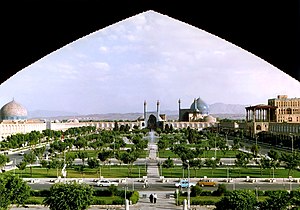
Back فن صفوي Arabic Səfəvi incəsənəti Azerbaijani Art safàvida Catalan Arte safávida Spanish هنر دوره صفوی Persian Art safavide French Arte safavide Italian Сефевидское искусство Russian Safevî sanatı Turkish
This article needs additional citations for verification. (June 2022) |

Safavid art is the art of the Iranian Safavid dynasty from 1501 to 1722, encompassing Iran and parts of the Caucasus and Central Asia. It was a high point for Persian miniatures, architecture and also included ceramics, metal, glass, and gardens. The arts of the Safavid period show a far more unitary development than in any other period of Iranian art.[1] The Safavid Empire was one of the most significant ruling dynasties of Iran. They ruled one of the greatest Persian empires since the Muslim conquest of Persia, and with this, the empire produced numerous artistic accomplishments.[2][3][4][5]
- ^ "ART IN IRAN ix. SAFAVID To Qajar Periods". iranicaonline.org.
- ^ Helen Chapin Metz, ed., Iran, a Country study. 1989. University of Michigan, p. 313.
- ^ Emory C. Bogle. Islam: Origin and Belief. University of Texas Press. 1989, p. 145.
- ^ Stanford Jay Shaw. History of the Ottoman Empire. Cambridge University Press. 1977, p. 77.
- ^ Andrew J. Newman, Safavid Iran: Rebirth of a Persian Empire, IB Tauris (March 30, 2006).
© MMXXIII Rich X Search. We shall prevail. All rights reserved. Rich X Search